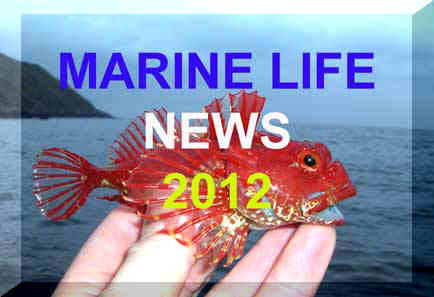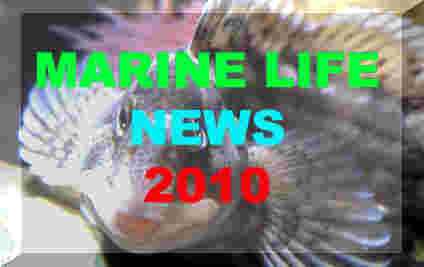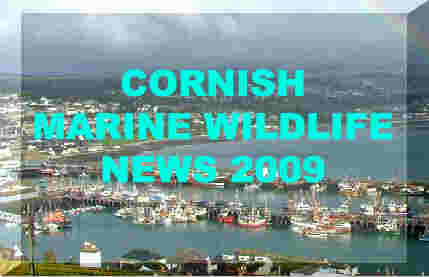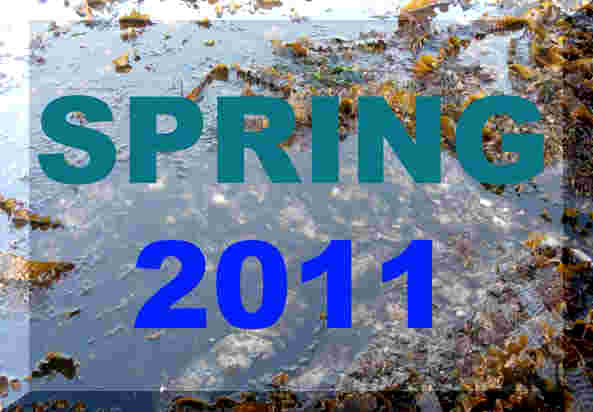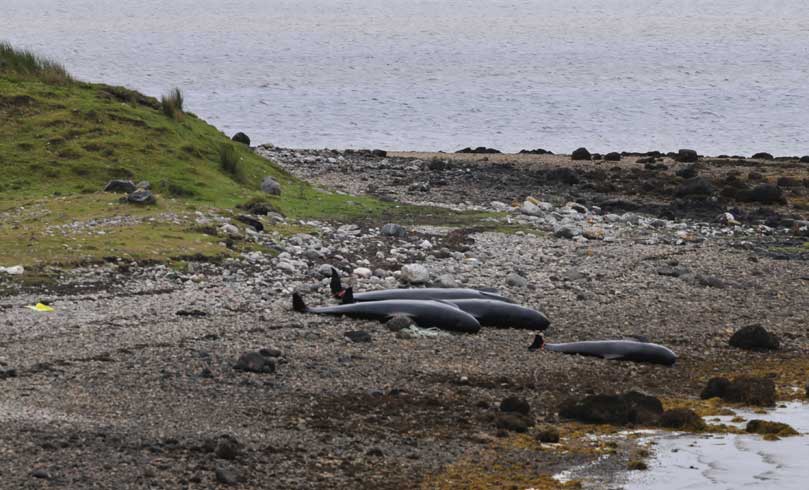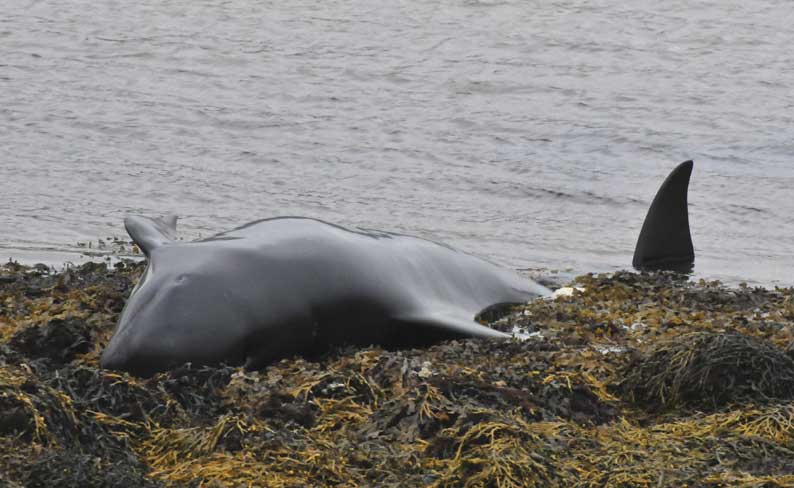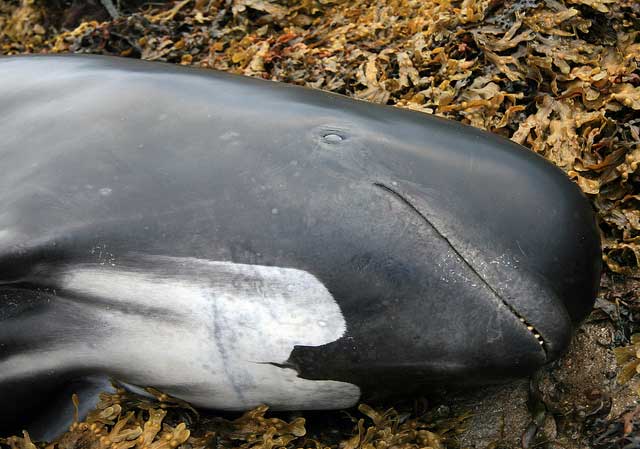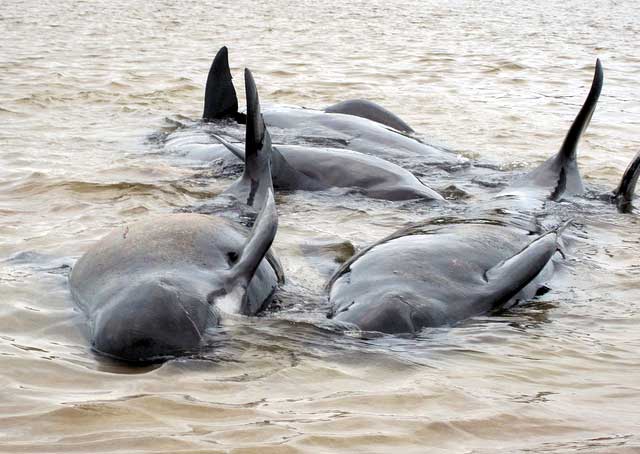LATEST
NEWS:
29
December 2011
A
young Kemp's Ridley Turtle,
Lepidochelys
kempii, was discovered on the shore
at Tresilian
Bay, near Llantwit
Major, on the south Wales coast. This was the first of these young
turtles
discovered dead after the gales. These endangered
turtles breed on the coasts of Mexico and are usually found in the Gulf
of Mexico and were thought to have blown across the Atlantic Ocean.
The turtle is likely to have perished in the cold seas.
Second
Report
BMLSS
Turtles
27
December 2011
A
Bearded Seal, Erignathus
barbatus, hauled out on a dock at Tayport
(on the south coast of the Firth
of Tay, near Dundee), east Scotland. Its arrival followed a spate of
storms
across Scotland.

A Bearded
Seal was also seen at St.
Cyrus
(near Aberdeen) about 30 miles further north in November
2011. In view of the rare sightings of this
Arctic seal around the British Isles it is likely to be the same one.
Previous
Report
20
December 2011
A
Hooded Seal, Cystophora
cristata, was discovered on
the beach at Chapel
St. Leonards,
Lincolnshire, was taken to the Skegness
Natureland Seal Sanctuary. The explanation for this unexpected arrival
may be because hat the seal had first been rescued by a Seal
Sanctuary at Friedrichskoog
in Germany in August. 2011and
was fitted with a radio
transmitter on its release. The eight month old pup was thin and exhausted
after swimming all the way to Scotland and up to the Orkney
Islands. If she had kept going she would have been on course to get
home to Iceland. Unfortunately she turned round and headed south along
the east coast of England and came to rest in Lincolnshire.
The
Hooded
Seal is an Arctic
species and even discoveries off the coast of Scotland, including the Orkney
and Shetland Isles are rare. It congragates to breed around Greenland and
the Denmark Strait
(between Iceland and Greenland) from June to August. For the rest of the
year ti tends to be a solitary animal.
Skegness
Natureland Sea Sanctuary News
Previous
Report 2004
BMLSS
Seals
15
December 2011
An
interesting large piece of wood was washed up on the strandline
at after storms on low tide at Sennen
Cove, Cornwall: it was completely covered in small to medium sized
Goose
Barnacles,
Lepas anatifera.
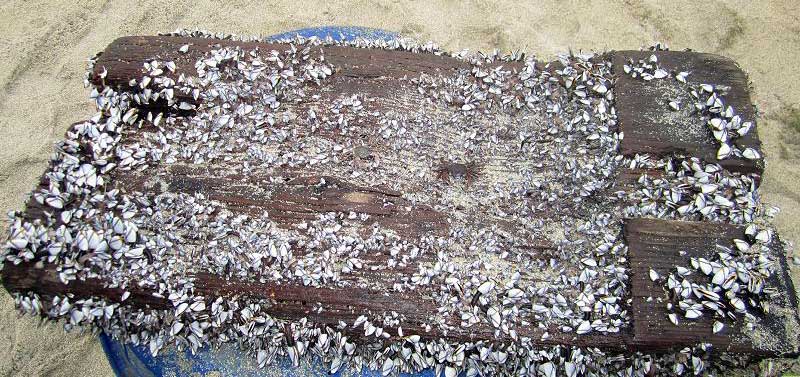
On
closer examination it was found to have a cavity at one end and tucked
into this was a male and a female Columbus
Crab,
Planes minutus. Small
3-4 mm egg masses and shipworm
holes were also seen which included the rarely recorded Bankia
gouldi; as
well as Teredora
malleolus, which
made up about 95% of the shipworms in the timber. Under a magnifying glass
and discovered a rare 14 mm pelagicsea
slug, Fiona
pinnata,
which has only been recorded
a few times in British seas.
Full
Report
BMLSS
Barnacles
BMLSS
Molluscs
BMLSS
Nudibranchs
BMLSS
Strandline Reports
13
December 2011
A
Green Turtle, Chelonia
mydas, was discovered on a beach in
South
Ronaldsay,
Orkney
Islands, (ND 463 900)
after the recent storms. Unfortunately it was freshly dead, but intact,
so its remains were sent to Scottish
Agricultural College Veterinary Laboratory at Inverness. The carapace
measured 290 mm long by 280 mm wide.
The
Green
Turtle inhabits tropical seas including the
Atlantic coast of Spain and the Mediterranean Sea. This turtle is only
very rarely recorded in British seas.
|
 |
Previous
Report in 2003
BMLSS
Turtles
1 December
2011
The
invasive alien Carpet Sea Squirt,
Didemnum
vexillum, has new been discovered
on the shore in Kent. This colonial
ascidian is an invasive
and unattractive smothering species from the Pacific Ocean off Japan. It
has occasionally been recorded in harbours but this is the first time it
has spread to adjoining areas around England.
BMLSS
Tunicates
A gastropod
mollusc
new to science, a pretty little false cowrie in the family Ovulidae,
Simnia
hiscocki,
was described from the Cornwall Peninsula, England, and compared with Simnia
patula occurring in the same area,
from which it differs in shell- and radula-morphological features as well
as ecological features. DNA analysis suggests that it is a very young species
whose host-specificity to the Pink Sea
Fan, Eunicella
verrucosa, makes it a potentially
useful species for monitoring sea-temperature-change.
BMLSS
Molluscs
BMLSS
Simnia
23
November 2011
An
extremely rare record of a Yellowfin Tuna,
Thunnus
albacares, was discovered and photographed
by Nigel Jones
at the foot of a cliff at Dunraven
Bay, near Porthcawl,
South Wales.
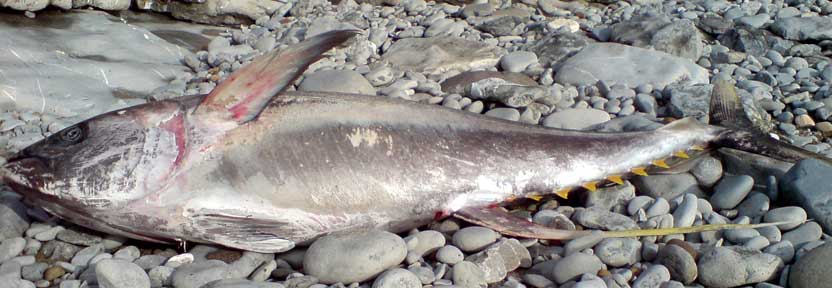
Yellowfin
Tuna
Photograph
by Nigel Jones
The
fish was identified from the photographs. It
was only the third discovery on record from British seas.
BMLSS
Tunnies
8 October
2011
Dr
Peter Evans, Director of the marine research
charity Sea Watch
Foundation, confirmed that a small whale spotted in Mounts
Bay next to the Cornish town of Penzance
was a Dwarf Sperm Whale,
Kogia
sima, a tropical/subtropical species
that has never before been recorded off the UK coast. This
is the smallest whale in the oceans, little more than the size of a Porpoise.
Images
BMLSS
Cetaceans
1
September 2011
Austin
Taylor captured a series of excellent
photographs of a Sei Whale,
Balaenoptera
borealis, at Firths
Voe, Mossbank, in the
Shetland
Isles.
Images
at Austin Taylor Photography
Sea
Watch Foundation on facebook
8 September
2011
Protection
for key nature sites in UK seas has come a step closer with the unveiling
of proposals to create over 100 Marine
Conservation Zones (MCZs).
The
zones range from tiny stretches of coastline to large tracts of sea floor.
The proposals were included in the Marine
and Coastal Access Act 2009
and cover seas abutting the English coast and waters around Wales more
than 12 miles from the coast. They will be assessed by an expert panel
before the government makes its final decision.
"The
thousands of species of sea life and habitats that live hidden under our
waters need just as much protection as those that we can see on land,"
said
Richard
Benyon, the Parliamentary
Under-Secretary of State at the Department
for the Environment, Food and Rural Affairs.
"We
will scrutinise the recommendations carefully," vowed
Peter
Ryder, chairman of the Marine
Protected Area Science Advisory Panel.
1
September 2011

A
species of Drumfish
Photograph
by Nick Eggar
This
fresh fish was discovered on sale at Plymouth
Fish Market. It was
probably captured in the south-western approaches (SW of Cornwall). However,
it identity is a bit of a puzzle and has provoked discussion amongst the
experts. It is definitely species of Drumfish
in the family Sciaenidae
as evidenced by two dorsal fins with the lateral line reaching all the
way to its caudal (tail) fin. However, none of the four European species
of Drumfish are normally found in British seas and its appearance does
not match any of them exactly.
The identity
of this fish is still under enquiry.
Richard
Lord makes a compelling case for this fish to be the Atlantic
Croaker, Micropogonias
undulatus, from a comparative
photograph he took at Fulton
Fish Market (New York). This species inhabits the shallow seas of the
Gulf
of Mexico and the Atlantic west coast of the United States of America
from Florida to Maine. This seems to be only the third record of this alien
fish in European seas as a previous
record
of two juvenile specimens has been discovered in Belgian waters (Southern
Bight of the North Sea): one in August 1998
as a by-catch of the commercial shrimp fishery
in coastal waters, another in October 2001
on a tidal flat in the brackish part of the Scheldt
Estuary.
Pharyngeal
Teeth of Drumfish
An
alternative possible species is the Chi Drumfish, Umbrina
cirrosa.
Another
candidate is the Corb, Sciaena
umbra.
 Please Email any ID suggestions.
Please Email any ID suggestions.
27
August 2011
A
Peacock
Blenny,
Salaria
pavo (Risso, 1810), was seen on the Brittany coast, northern France:
"It was found on the shore in the Golfe
du Morbihan
in south Brittany.
They were the commonest fish on the shore, under rocks from mid-shore down."

Peacock
Blenny
Report
and Photograph
by David Wilson
on the Porcupine
MNHS Facebook
page.
This
the most northerly occurrence of this Mediterranean blenny
recorded.
BMLSS
Blennies
15
August 2011
One
of the rarer deep water whales found around the
British coast, a Sowerby's
Beaked Whale,
Mesoplodon bidens,
washed up near Thornham
on the Norfolk coast.
Unfortunately, the whale was was both washed up high on the salt
marshes and was in such a poor condition out of the water it had to
be euthanised.
23
July 2011
The
grim predictions turned out to be accurate as 25 Long-finned
Pilot Whales, Globicephala melas,
died
over night, 15 stranded at low tide on the sandbanks
at
Kyle of Durness,.
A further 44 survived, a few of them successfully rescued by the efforts
of the British
Divers Marine Life Rescue, rescuers
from the Maritime
and Coastguard Agency (MCA), Scottish
Agricultural College (SAC), Whale
and Dolphin Conservation Society (WDCS) and other helpers in this remote
location. 44 of the Pilot Whales
successfully swam out to deeper water and away from danger.
Report
by Colin Bird (Link)
Stranded Pilot Whales
Photographs ©
by Wendy Sutherland
(Thrumster,
Caithness)
22
July 2011
Up
to 15 out of a large school of sixty plus Long-finned
Pilot Whales, Globicephala melas,
were
spotted at high tide in 3.5 metres water in the
narrow Kyle of Durness,
on the remote northern Scottish mainland coast. There were concerns for
their safety as at low
tide the water in the shallow inlet is only 1.5 metres deep and contains
numerous sandbanks. (Report entered two hours
before low tide.)
Stranded Pilot Whales
Photographs ©
by Alan Airey
Whales
& Dolphins Gallery (by Alan Airey)
Update:
Three whales, including a calf,
had already stranded as the water in the estuary dropped.
Low
Tide Update 8:00 pm: From
the original group of whales
that entered the Kyle of Durness earlier in the day, thirty
stranded live on a sandbank, with two having died. The
original four animals that stranded earlier were still being cared for
by trained medics and around twenty animals were still in the shallow water.
British
Divers Marine Life Rescue
BMLSS
Cetaceans
Defra
Report on the deaths
17
June 2011
A
dead and decomposed Moray Eel, Muraena
helena,
was removed from the water by the Condor ferry ramp in St.
Peter
Port Harbour, Guernsey. This southern
sub-tropical species is an extremely rare discovery in British seas and
is normally found found around the Azores,
Canary
Islands and in the Mediterranean
Sea and further south. The last discovery
in Guernsey
seas was in 1996.
11
June 2011
Environmental
Festival & Adur World Oceans Day 2011
Understanding
and celebrating our marine environment
The
wind
and rain held off for the eleventh
Adur
Environment Festival and Adur
World Oceans Day went well in the marquee on
Coronation
Green, by Shoreham
Footbridge at the High Street
end on the second Saturday
of the Adur Festival. Len
Nevell of the British
Marine Life Study Society was there with the usual exhibition of lobsters
and crabs.
World
Oceans Day on Facebook
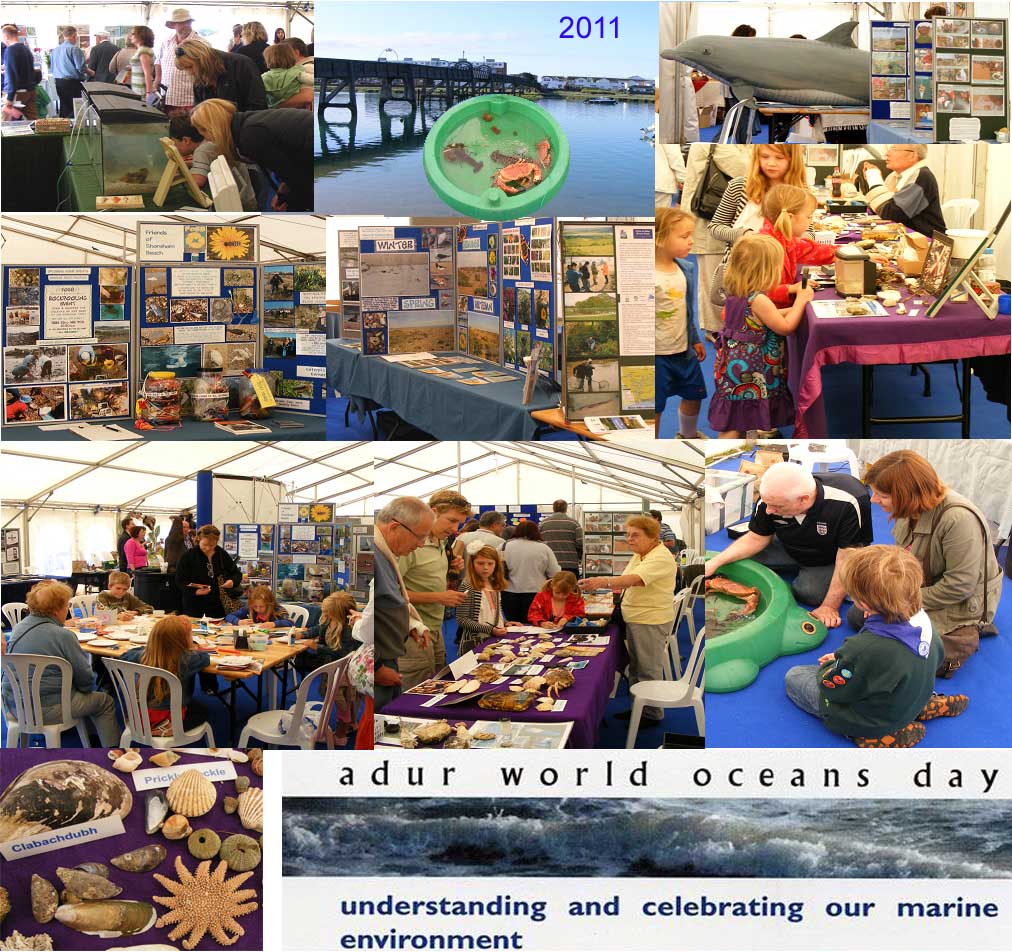
"The
aim of the event is to introduce the young visitors to the world of the
sea and seashore,
an opportunity they may not get. It is an educational event with an opportunity
for children to participate in the interactive
activities."
Quote
by Andy Horton (British Marine
Life Study Society)
Adur
World Oceans Day Blogspot 2011 et seq.
8 June
2011
A Spotted
Bass, Dicentrarchus
punctatus, was caught on rod and line
by Lee Allen
off the west coast of Jersey, Channel Islands. This
southern warm water species is a rare visitor to the English Channel and
differs from the common Bass,
Dicentrarchus
labrax, by having dark black spots on its
silver flanks. Only a handful of Spotted Bass
have
been reported from British seas, but some fish may have been dismissed
as a variant of the Bass
rather than a different species.
31
May 2011
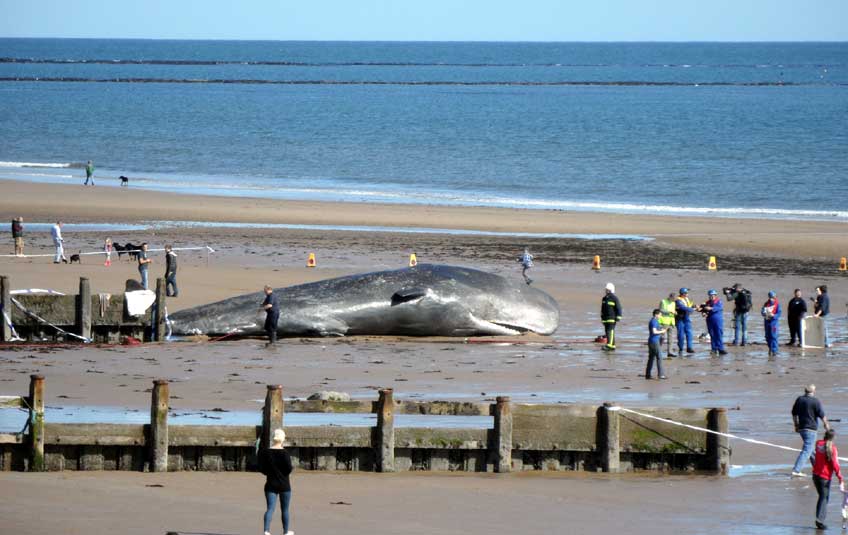
A
10.6 metre Sperm Whale, Physeter
macrocephalus, was discovered washed up alive
at dawn on the sandy beach at Redcar,
Cleveland,
near Middlesborough, in the north-east of England. The stricken 20 tonne
mammal died a few hours later about 9.00 am.
BMLSS
Cetaceans
21
May 2011
A
large pod of 21 Fin Whales,
Balaenoptera
physalis, was spotted in an area known
as the Celtic
Deep, between north Cornwall and south west Pembrokeshire, about 60
miles offshore. Becky Scott
explained: “We saw five groups of Fin Whales
in little over half an hour, in group sizes of up to seven. The whales
were blowing frequently and some were lunge-feeding near the surface.”
Fin
Whale Photograph by Dr Tom Brereton
"“We
have been monitoring Fin Whale
numbers in their Bay
of Biscay stronghold for over 15 years, so we are used to seeing large
numbers, but to see so many within British waters in close proximity is
unprecedented and an exciting new discover," said
Dr
Tom Brereton of Marinelife.
Dr
Jeroen van der Kooij from Cefas
commented: “acoustic echosounders detected
dense layers of krill
as well as sandeel
schools in the area, both of which are known to be key food sources for
these animals.”
19
- 22 May 2011
A
large school of sixty plus Long-finned
Pilot Whales, Globicephala melas, were
spotted swimming around in the confined shallow coastal
sea area of Loch Carnon,
South
Uist, in the
Outer
Hebrides,
Western
Isles, Scotland. Twenty of the small whales were recognised as being
injured from colliding with rocks in the narrow sea inlet that opens out
into the Sea
of the Hebrides on the eastern side of the island. Experienced cetacean
watchers said that the whales were very vocal. As with the school that
visited the loch on 2010,
there were serious concerns that the school of whales would become stranded
on the shore with healthy whales following the sick and injured to their
deaths. Finally the large school left the loch and swam south, but still
close to the rocky coastline.
Map
of the Hebridean Seas
Map
of Carnan Pier Area
BMLSS
Cetaceans
Previous
Report from Loch Carnan 2010
 |
15
May 2011
An
unusual orange European Lobster,
Homarus
gammarus, was caught by a fisherman Steph
Noel near Icho Bank, South of St Helier, Jersey,
in his pots with the usual blue lobsters. Steph
had only caught three similarly coloured lobsters in 27 years of fishing
for them. The lobster was returned to the
sea.
BMLSS
Abnormal Lobsters
|
21
April 2011
A
Boar
Fish (or Zulu Fish),
Capros
aper, was behaving strangely, swimming
near the surface on an exposed rockpool at Challaborough
Beach,
south Devon, and we moved it from where we found it to a more secluded
pool.
This
pretty deep water fish is occasionally found in shallow water of the south-west
of England with occasional specimens a notable and interesting discovery
between the tides.
BMLSS
Boar Fish
3
March 2011
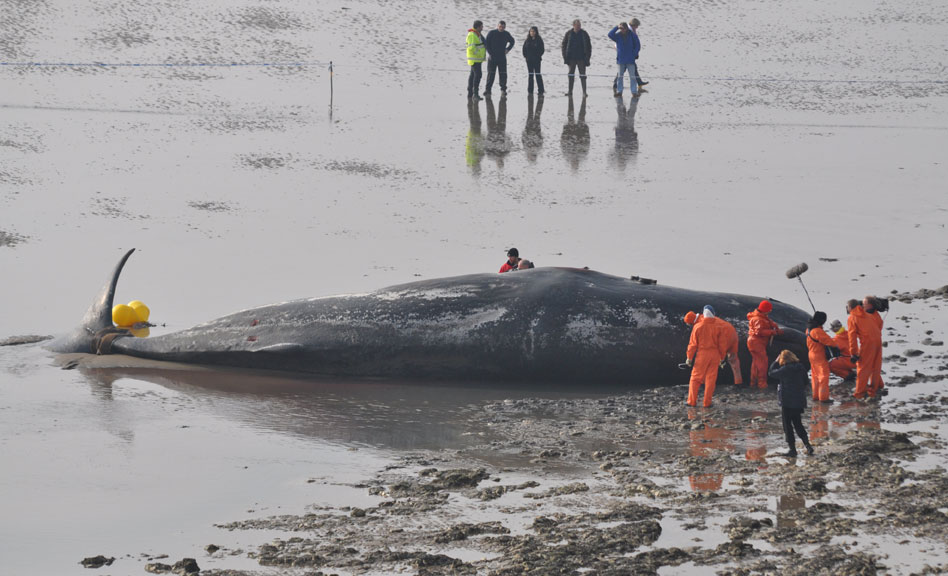
A 13.7
metre long Sperm Whale, Physeter
macrocephalus, was washed ashore dead
at Pegwell Bay in
north-east Kent. This deep water whale was suffering from starvation and
dehydration. Sperm Whales
are unusual in the relatively shallow water of the southern North Sea.
News:
Sperm Whale stranded dead off the Northumberland Coast 2010
20
January 2011
Two
large adult Fin Whales,
Balaenoptera
physalis, announced their presence
by blowing at the surface, of the southern
Irish
Sea, their spouts seen from from the
Fishguard
(Wales) to Rosslare
(Ireland) car ferry.
"It
was incredibly exciting, the whales blast a thirty foot (10 metres) high
column of vapour skywards as they surface to breath. In the cold winter
air. The blow hangs in the sky like a massive crystal plume before slowly
dissipating" (by Cliff
Benson, Sea Trust.)
These
whales have been seen before in winter but it it is the first sighting
during the winter months.
Sea
Trust Welsh Sightings
BMLSS
Cetaceans
6 January
2011
A
mass stranding of crabs occurred on the Isle
of Thanet
coast, Kent; about 40,000 Velvet
Swimming Crabs,
Necora
puber, were discovered on the strandline
amongst lesser numbers of molluscs, sea
anemones, sponges and other washed up invertebrates.
Previous
Report 2010
British
Marine Life News 2010

Cornish
Marine Life Records 2009
BMLSS
Oil Disasters page


